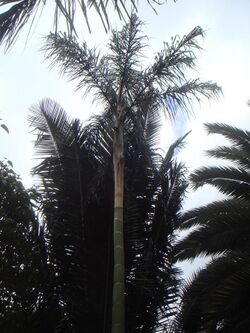Biology:Ceroxylon vogelianum
| Ceroxylon vogelianum | |
|---|---|

| |
| Ceroxylon vogelianum cultivated at Bogota Botanical Garden. | |
| Scientific classification | |
| Kingdom: | Plantae |
| Clade: | Tracheophytes |
| Clade: | Angiosperms |
| Clade: | Monocots |
| Clade: | Commelinids |
| Order: | Arecales |
| Family: | Arecaceae |
| Genus: | Ceroxylon |
| Species: | C. vogelianum
|
| Binomial name | |
| Ceroxylon vogelianum (Engel) H.Wendl.
| |
| Synonyms[1] | |
| |
Ceroxylon vogelianum, also known as the Vogels wax palm is a palm native to the Andes from Venezuela south to Peru in humid montane forest, at an elevation of 1900 – 2900 meters.[2]
Description
Ceroxylon vogelianum is a small to medium-sized palm with a stem of 3–17 meters tall and 12–25 cm in diameter.[2] The crown can have 6 to 18 leaves, most of them almost upright or horizontally arranged.[2] Leaf blades are made of 46–129 leaflets in a rhachis of 38–210 cm long; petiole 15–75 cm long.[2] Male inflorescences around 160 cm long, with about 40 branches; male flowers with 6 stamens, with filaments up to 1.5 mm long and anthers 1.6–2.5 mm long.[2] Female inflorescences around. 360 cm long with 31–53 branches; female flowers with 6 staminodes and a green pistil of 2–3 mm in diameter.[2] Fruits globose, orange-red when ripe, 1.6–2.0 cm diam. with seeds 1.1–1.6 cm diam.[2]
Distribution and habitat
This species is present in the Andes from Venezuela to Colombia, Ecuador, and Peru.[2] It occurs in humid montane forest, between 1900–2900 meters of elevation, with sparse individuals.[2]
References
- ↑ "The Plant List: A Working List of All Plant Species - Ceroxylon vogelianum (Engel) H. Wendl.". http://www.theplantlist.org/tpl1.1/record/kew-37277.
- ↑ 2.0 2.1 2.2 2.3 2.4 2.5 2.6 2.7 2.8 Sanin, Maria Jose; Galeano, Gloria (2011). "A revision of the Andean wax palms, Ceroxylon (Arecaceae)". Phytotaxa (34): 1–64. http://www.mapress.com/phytotaxa/content/2011/f/pt00034p064.pdf. Retrieved 18 January 2016.
Wikidata ☰ Q15463306 entry
 |

